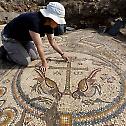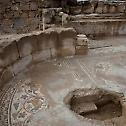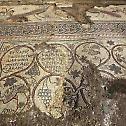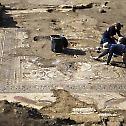Marvelous mosaics revealed inside 1,500-year-old church in Israel
A 1500-year-old church building, dating to the Byzantine era, was uncovered in Israel on Wednesday. The Israel Antiquities Authority was excavating a site where the Israel Land Authority is beginning new construction on a neighborhood in Moshav Aluma. The 1,500-year-old church building was a surprise to archaeologists, as it was the first of its size found in the area.
Archaeological finds are always exciting in Israel because of the rich religious tradition and history found in the region. The Byzantine era existed from the 4th century until 15th century, when modern day Istanbul, then Constantinople, fell to the Ottoman Turks. They scattered large basilicas from Europe to Israel. As a continuation of the Roman Empire, they were known for their ornate structures and use of religious relics.
The discovery of this Church building in southern Israel did not disappoint in the production of ancient artifacts. The gem of this find was “a fine mosaic floor decorated with colored geometric designs; at its center, opposite the entrance to the main hall, is a twelve-row dedicatory inscription in Greek containing the names Mary and Jesus, and the name of the person who funded the mosaic’s construction.”
Featured in the beautiful mosaic was over 40 medallions displaying ornately designed zebras, leopards, turtles, wild boars, and birds. A Christ monogram was also discovered in one of the many mosaics that decorated the floors and halls of the building. Utilizing the Greek letters Chi and Rho, the church often symbolized Jesus’ title as the Christ by forming a symbol. Though it looks like a cross, it is actually meant to be a reminder of the authority Jesus had as the chosen one of God.
The 1500-year-old church building was surprisingly still well intact. It spanned 72-by-39-feet (22-by-12-meter) and utilized vast columns. Archaeologists Dr. Daniel Varga and Dr. Davida Dagan also discovered a large courtyard and various glass vessels, helping to date the excavation. The Aluma basilica is the only one of its kind in the area and a very rare find on the road between Ashkelon and Jerusalem.
Islamic walls and Ottoman garbage dumps were piled on top of the 1500-year-old structured, so it took some digging to uncover. The site will be open to the public Thursday and Friday. After the archaeologists are done digging, they will remove the mosaics and relics. Before building begins by the Israel Land Authority, the site will be covered.
Source: NBC News





